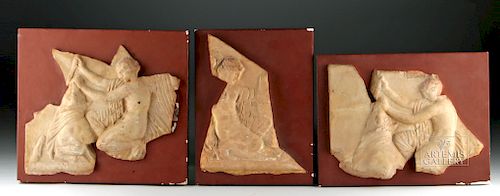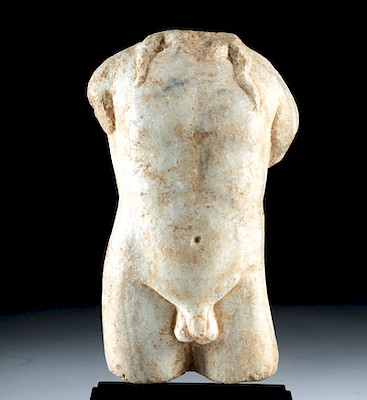Hellenistic Greek Terracotta Reliefs - Europa & Bull
Lot 25b
About Seller
Artemis Gallery
686 S Taylor Ave, Ste 106
Louisville, CO 80027
United States
Selling antiquities, ancient and ethnographic art online since 1993, Artemis Gallery specializes in Classical Antiquities (Egyptian, Greek, Roman, Near Eastern), Asian, Pre-Columbian, African / Tribal / Oceanographic art. Our extensive inventory includes pottery, stone, metal, wood, glass and textil...Read more
Estimate:
$7,000 - $9,000
Absentee vs Live bid
Two ways to bid:
- Leave a max absentee bid and the platform will bid on your behalf up to your maximum bid during the live auction.
- Bid live during the auction and your bids will be submitted real-time to the auctioneer.
Bid Increments
| Price | Bid Increment |
|---|---|
| $0 | $25 |
| $300 | $50 |
| $1,000 | $100 |
| $2,000 | $250 |
| $5,000 | $500 |
| $10,000 | $1,000 |
| $20,000 | $2,500 |
| $50,000 | $5,000 |
| $100,000 | $10,000 |
| $200,000 | $20,000 |
About Auction
By Artemis Gallery
Dec 5, 2018
Set Reminder
2018-12-05 10:00:00
2018-12-05 10:00:00
America/New_York
Bidsquare
Bidsquare : DAY 1 | Classical Antiquities & Asian Art
https://www.bidsquare.com/auctions/artemis-gallery/day-1-classical-antiquities-asian-art-3698
Day 1 of an important 2-day auction featuring ancient and ethnographic art from around the world. Egyptian, Greek, Roman, Viking, Near Eastern plus Asian Art from China, Japan, Thailand, Vietnam, Burma, India, more. Artemis Gallery info@artemisgallery.com
Day 1 of an important 2-day auction featuring ancient and ethnographic art from around the world. Egyptian, Greek, Roman, Viking, Near Eastern plus Asian Art from China, Japan, Thailand, Vietnam, Burma, India, more. Artemis Gallery info@artemisgallery.com
- Lot Description
Ancient Greece, Hellenistic, from Tarantine, ca. 3rd to 1st century BCE. Three terracotta wall reliefs depicting Europa slaying the Bull (Zeus) - a favorite theme from Classical mythology - most likely created for a frieze or metopes. Two of the three reliefs show a kneeling Europa, facing right and holding the bull by his muzzle, about to strike with her weapon; the third shows Europa facing left in a kneeling pose. All are delineated in low to high relief and have nice remains of red pigment (particularly on her coiffure) and traces of white pigment. All are set on rectangular plaster mounts that are tastefully painted a rich russet red. Size: largest panel measures 14.5" W x 13" H (36.8 cm x 33 cm)
In Greek mythology, Europa was a Phoenician lady of elite lineage, for whom the continent of Europe was ultimately named. The iconography of these reliefs was inspired by the legendary Cretan story of Zeus abducting her in the form of a white bull. According to Karl Kerenyi, "most of the love-stories concerning Zeus originated from more ancient tales describing his marriages with goddesses. This can especially be said of the story of Europa." (The Gods of the Greeks, Thames and Hudson, p. 108) Enamored of Europa, Zeus elected to seduce her in a crafty fashion, transforming himself into a tame white bull so that he could blend in with her father's herds of cattle. When Europa was gathering flowers with her attendants, she noticed the bull, petted him and eventually mounted his back. Zeus took full advantage of the moment, made his way to the sea and swam to the island of Crete, all the while with Europa on his back. Once they arrived, Zeus revealed his true identity to Europa, and she became the first queen of Crete. Europa bore Zeus three sons, including Minos the ruler of Crete, Rhadamanthys who ruled the Cyclades, and Sarpedon who ruled Lycia. In time she married Asterius, the king of Crete, and was worshipped under the name of Hellotis in Crete, where the festival Hellotia was held in her honor.
Europa was the source of inspiration for several works of Classical literature. In the mid 2nd century BCE, the poet Moschos wrote a Hellenistic epic about Europa. Ovid's "Metamorphoses" describes Jupiter's seduction, "And gradually she lost her fear, and he/Offered his breast for her virgin caresses,/His horns for her to wind with chains of flowers/Until the princess dared to mount his back/Her pet bull's back, unwitting whom she rode/Then — slowly, slowly down the broad, dry beach —/First in the shallow waves the great god set/His spurious hooves, then sauntered further out/'til in the open sea he bore his prize/Fear filled her heart as, gazing back, she saw/The fast receding sands. Her right hand grasped/A horn, the other lent upon his back/Her fluttering tunic floated in the breeze."
This piece has been tested using thermoluminescence (TL) and has been found to be within the age range listed above; if purchased, you will receive a report confirming its age.
Provenance: private East Coast, USA collection
All items legal to buy/sell under U.S. Statute covering cultural patrimony Code 2600, CHAPTER 14, and are guaranteed to be as described or your money back.
A Certificate of Authenticity will accompany all winning bids.
We ship worldwide and handle all shipping in-house for your convenience.
#136226Fragments with losses as shown and repaired from approximately 6 to 8 pieces in total. Surface wear with abrasions to some high-pointed areas. Still in remarkably good condition given that they are Hellenistic, and that they are terracotta reliefs. Minor pigment losses to the painted plaster mounts.Condition
- Shipping Info
-
All shipping is handled in-house for your convenience. Your invoice from Artemis Gallery will include shipping calculation instructions. If in doubt, please inquire BEFORE bidding for estimated shipping costs for individual items.
-
- Buyer's Premium



 EUR
EUR CAD
CAD AUD
AUD GBP
GBP MXN
MXN HKD
HKD CNY
CNY MYR
MYR SEK
SEK SGD
SGD CHF
CHF THB
THB
















